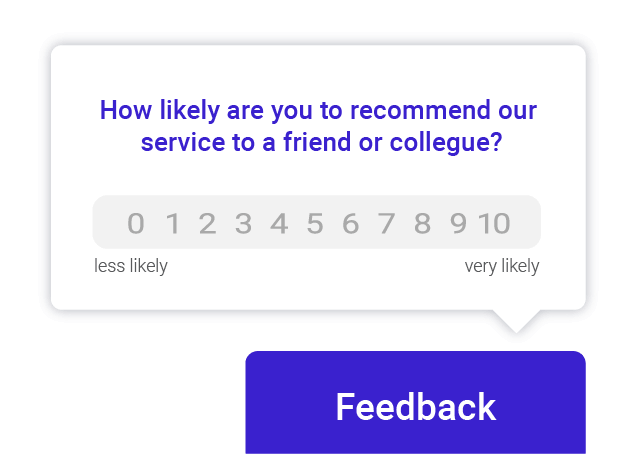Developing your website and a building the customer experience can be a lot of trouble, especially at early stages. Edmonton Web Designers will help you roll out the product, with better engagement rates that are far lower than you expected.
Any product, whether it’s a website or a service, needs testing to perfect it. This includes gathering information on performance as well as the opinions of those who use the product.
Here’re 5 tips we observed from our customers on how test, measure and improve customer experience (CX) for websites or applications.
1. In-the-moment website feedback
You may think of customer feedback surveys as something tedious. You may imagine a boring 20 question survey with multiple answers that you send via mail and hope for 5% response rate.
It doesn’t have to be like this. The key to getting more feedback is making it easier for customers to respond. Sending surveys via mail and asking customers to spend their time to complete them isn’t going to cut it.
Gathering customer experience feedback directly from your website “in the moment” is going to give you more productive results.

With ROWNMI Marketing Web Designs, it only takes one intuitive click for a customer to express their opinion and leave their feedback. It’s way easier than typing something or jumping to another website to load the survey questions.
The best part about this in-app feedback approach is that you don’t have to reach out to all customers to find the people who are willing to take the whole survey. If you have more questions you want customers to answer, you can set the questions to open up after the initial questions is answered. This feature immensely boosts the engagement rate of survey response.
The people who took time to check on your website are more likely to continue to find more information turning into a lead. This way, you’re using the micro-moment when they have some free time to collect more data. That’s more feedback for you, and less customers frustrated from constant survey requests.
There’s one thing you have to take into account, however. Have you ever seen a website that shows you a pop-up with a discount or a survey right away? You’ve probably closed that pop-up.
Don’t be that website. Don’t ask for feedback the second a person enters your website. For starters, they may not have an idea whether they like you or not. Even if they know your business already, they’re more likely to close the pop-up than to answer the question.
2. Use a personal chat box to engage visitors
Sometimes your customers don’t want to browse your site to get the answers. They need them right here and right now. Naturally, if they don’t get them now, they will find someone else to help with their problem.
However, choosing a good live chat software like facebook messenger is not enough. Your employees have to respond to questions fast, or you risk losing a customer.
But many websites have a live chat. How can you stand out? When it comes to customer experience, it’s not so much about what you offer, but “how” you offer.
Make your website customer experience unique and personal by offering a quick response time.
Canva, one of our coolest customers, increased customer feedback engagement rate by 215% after using our tool. Visual feedback allows customers to indicate graphic issues easily and likewise for customer service agents. You’ll be able to respond to customers’ questions fast and point to navigation’s specific to their browser.
When you help people with such speed and precision, you’re bound to create a great website customer experience.
3. Thumbs up/down on website customer experience
The NPS rating in the first chapter was so effective because it leveraged a moment when a particular customer was more likely to engage. This allows you to scale up for more feedback.
You can use the same technique to collect instant feedback on content published on your website. Gartner research says collecting feedback right after a specific interaction/experience is more accurate even if compared to feedback taken within 24 hours.
Keep it simple, thumbs up/down or emojis are both great ways to measure customer experience.
You can even measure the response to specific content pieces like banners or widgets with micro-interactions. Add the thumbs up/down rater near a piece of content, and you’ll receive the feedback you need.
4. Get feedback upon exit to detect intent
Not all customers are going to be satisfied with your website. But you can leverage the ones that want to leave to learn about your shortcomings.
ROWNMI can be configured to detect exit intent and send a feedback pop-up when the customer is close to leaving your website. A flashy animation is likely to draw their attention, so the response rate will give you some chances of learning why do they leave.
Make sure the feedback form is easy and fast to answer. Otherwise, the customer may as well go on and leave. Think through all possible reasons for them leaving and make these reasons questions in the survey.
Follow the same tactics you used in the first chapter. Don’t show multiple questions at once. Instead, show more questions to people who have already answered one.
When a customer answers all the questions from your exit survey, encourage them with a discount or a gift. They may decide to stay after all.
5. Use customer interviews for in-depth learning
Customer experience is key to success these days. Gartner research shows that competition between 89% of businesses is CX.
Meanwhile, companies are extremely oblivious to their customer experience. Bain & Co research illustrates that 80% of businesses believe their CX is great, while only 8% of users think so.
Don’t be one of those companies. Ask your customers for interviews to learn more about their experience. You may have to incentivize them with a gift or a bonus for this, but it pays.
We, at ROWNMI Marketing, regularly conduct customer interviews with different types of customers. This has helped us uncover opportunities to expand our product features as well as reduce churn rate.
